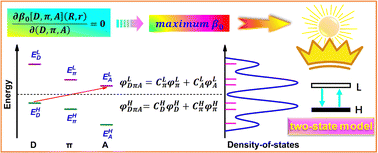The search for a maximum of the D–π–A paradigm for second order nonlinear optical molecular materials†
Abstract
Push–pull π-conjugated molecules are one of the paradigms of second order nonlinear optical (NLO) materials and have been extensively explored. However, high-performance second order NLO materials with an optimum electron donor (D), π-bridge (π) and acceptor (A) under this paradigm are still the most sought-after. In the present work, D–π–A molecules with optimal D, π and A combination for strong second order NLO properties are proposed based on molecular orbital theories. The optimal D–π–A push–pull molecule achieves an unprecedentedly strong NLO response under the D–π–A paradigm, i.e., the static first hyperpolarizability reaches −453.92 × 10−30 esu per heavy atom using azulene as part of the π-bridge and acceptor to synergistically reinforce the strength of the acceptor. The protocols of D–π–A NLO molecule design through frontier molecular orbital matching of D, π and A with optimal combination of electron donating and accepting strengths shed light on future molecular NLO materials exploration. The simulated two-dimensional second order spectra provide useful information (e.g., sum frequency generation) on the applications of those D–π–A push–pull molecules in nonlinear optics.



 Please wait while we load your content...
Please wait while we load your content...